The masked tityra, Tityra semifasciata, is one of the species which has just sprung a scientific surprise. Researchers found animals and birds in temperate zones evolve faster than those in the tropics. Their suggestion is that extinctions happen more often in temperate regions where there is less species diversity.
Image: BBCNews.
People Hurting Birds
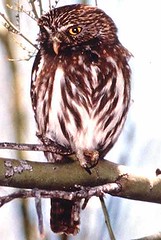 An Arizona Appeals Court has upheld the U.S. Fish and Wildlife Service's decision to remove the cactus ferruginous pygmy-owl, Glaucidium brasilianum cactorum (pictured, image: Bob Miles, USFWS), from the list of endangered species, paving the way for Arizona developers to build more track homes in the desert. According to the National Association of Home Builders (NAHB), the court battle clears the way to develop large swaths of land that was otherwise home to the Pygmy owl. Arizona developers have argued that the owl is not unique in its habitat in that they thrive further South in Mexico. "With this decision, the courts are sending a clear message that the pygmy owl listing is unjustified and it's time to move forward," said NAHB President Brian Catalde, a home builder in Southern California.
An Arizona Appeals Court has upheld the U.S. Fish and Wildlife Service's decision to remove the cactus ferruginous pygmy-owl, Glaucidium brasilianum cactorum (pictured, image: Bob Miles, USFWS), from the list of endangered species, paving the way for Arizona developers to build more track homes in the desert. According to the National Association of Home Builders (NAHB), the court battle clears the way to develop large swaths of land that was otherwise home to the Pygmy owl. Arizona developers have argued that the owl is not unique in its habitat in that they thrive further South in Mexico. "With this decision, the courts are sending a clear message that the pygmy owl listing is unjustified and it's time to move forward," said NAHB President Brian Catalde, a home builder in Southern California.
People Helping Birds
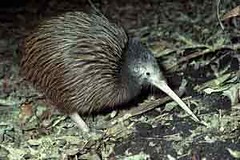 Two North Island brown kiwi, Apteryx australis mantelli (pictured, image Rod Morris), found out what it felt like to fly after boarding a plane in Christchurch and landing in Rotorua to be escorted to their new home in Te Puke. The two kiwi, named Whetu and Maui, were raised as part of a national captive rearing program at Willowbank Wildlife Reserve. They are the first North Island brown kiwi to be reintroduced into Otanewainuku forest in Te Puke after four years of joint preparation by the Otanewainuku Kiwi Trust and the Department of Conservation. "This is a great milestone for us. Our volunteers have spent thousands of hours removing pests and predators from more than 1000 hectares of untouched native forest in order to prepare the environment for a safe and successful kiwi release."
Two North Island brown kiwi, Apteryx australis mantelli (pictured, image Rod Morris), found out what it felt like to fly after boarding a plane in Christchurch and landing in Rotorua to be escorted to their new home in Te Puke. The two kiwi, named Whetu and Maui, were raised as part of a national captive rearing program at Willowbank Wildlife Reserve. They are the first North Island brown kiwi to be reintroduced into Otanewainuku forest in Te Puke after four years of joint preparation by the Otanewainuku Kiwi Trust and the Department of Conservation. "This is a great milestone for us. Our volunteers have spent thousands of hours removing pests and predators from more than 1000 hectares of untouched native forest in order to prepare the environment for a safe and successful kiwi release."
The celebration of Saint Patrick's Day coincides with New Zealand's first Green Kiwi Day -- a day dedicated to educating children about the importance of saving New Zealand's native birds. The brainchild of One Helix Trust, a charitable trust dedicated to the preservation of NZ's endangered bird and wildlife, Green Kiwi Day aims to stimulate children into action with achievable and practical steps that they (and their parents) can take to help protect NZ's native birds, including the kiwi, takahe, the rare blue duck, the kakapo and the endangered New Zealand falcon. "Green Kiwi Day is all about getting kids inspired and motivated about saving our unique wildlife. As the future of our country, our children hold the key to protecting our precious species."
The San Francisco Board of Supervisors on Tuesday is expected to pass legislation protecting the habitat of the famed parrots of Telegraph Hill. The legislation, proposed by Supervisor Bevan Dufty, was passed 9-1 on its first reading last week, said Boe Hayward, a legislative aide to Dufty. The birds, longtime local celebrities, gained international fame in Judy Irving's 2003 documentary "The Wild Parrots of Telegraph Hill." The film chronicles the flock's friendship with formerly homeless musician Mark Bittner.
Rare Bird News
A change in climate could be the cause of the early arrival of orange-bellied parrots to the south-west. Co-ordinator for the South West Orange-Bellied Parrot Working Group, Dianne Davis, said one of the rare birds was spotted with a flock of blue-winged parrots on a property at Killarney last week. "The first sighting is usually in April but each year we are seeing them coming earlier and earlier,'' said Davis. She also said similar changes were also being seen in the migratory patterns of other species of birds.
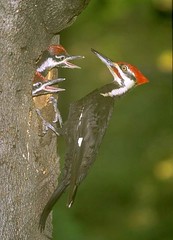 Video evidence that an extinct woodpecker is alive and well in Arkansas, USA may prove to be a case of mistaken identity. Further analysis of the video of what might be an Ivory-billed woodpecker, Campephilus principalis, appears instead to be footage of a pileated woodpecker, Dryocopus pileatus (pictured with nestlings, image: Erik Lewis), according to Martin Collinson from Aberdeen University, Scotland.
Video evidence that an extinct woodpecker is alive and well in Arkansas, USA may prove to be a case of mistaken identity. Further analysis of the video of what might be an Ivory-billed woodpecker, Campephilus principalis, appears instead to be footage of a pileated woodpecker, Dryocopus pileatus (pictured with nestlings, image: Erik Lewis), according to Martin Collinson from Aberdeen University, Scotland.
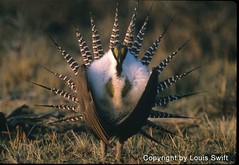 Federal and state government agencies, ranchers and farmers, and conservation groups have teamed up in recent years in a quest to keep the greater sage-grouse, Centrocercus urophasianus, and Gunnison sage-grouse, Centrocercus minimus (pictured, image: Louis Swift), off the federal endangered species list. "Caring is critical to the conservation of the species, but in addition we're going to have to be smart if we still want to have sage grouse in Utah in 100 years," said Joan Degiorgio, a regional director for the Nature Conservancy of Utah.
Federal and state government agencies, ranchers and farmers, and conservation groups have teamed up in recent years in a quest to keep the greater sage-grouse, Centrocercus urophasianus, and Gunnison sage-grouse, Centrocercus minimus (pictured, image: Louis Swift), off the federal endangered species list. "Caring is critical to the conservation of the species, but in addition we're going to have to be smart if we still want to have sage grouse in Utah in 100 years," said Joan Degiorgio, a regional director for the Nature Conservancy of Utah.
Avian Influenza News
Avian influenza has claimed two lives in Laos, 13 in Egypt, and 65 in Indonesia.
Throughout human history, diseases and epidemics have changed the patterns of royal succession, thwarted invasions by decimating whole armies and have disrupted commerce with calamitous results. In the Middle Ages in Europe, nearly one in three persons died of the plague. New emerging diseases such as HIV, SARS and avian Influenza (bird flu) have exacted a toll on our population and our economy. Other diseases and new public health threats wait in the wings to challenge the vitality of our communities. This article takes a sobering look at avian influenza.
The European Medicines Agency has adopted a positive opinion recommending the granting of a Community authorization for a third avian influenza vaccine for use in birds. The vaccine, Nobilis Influenza H7N1, from Intervet International BV, is an inactivated, adjuvanted avian influenza vaccine for administration by injection in chickens and ducks. The use of this product will be restricted to disease control campaigns carried out by national authorities in compliance with European Community legislation.
Scientists say a new report brings good news regarding Alaska's potential avian influenza threat. Last spring, many were concerned that millions of wild birds migrating from Asia might bring a deadly strain of bird flu, known as H5N1, with them. A new report says the threat may not be as bad as many people feared. After taking almost 20,000 samples from wild and domestic birds last year, scientists say they can not find any examples of Asian bird flu making its way to Alaska.
The protocol for the importation of horses to Hong Kong for the Beijing Olympics 2008 has been finalized. Officials are recommendeding that all horses be given a booster vaccination against equine influenza between 1 and 2 months before entry to a pre-quarantine facility (regulatory period 90-14 days), to ensure an optimal immune level and minimise the risk of influenza issues causing an importation problem. Horses suffering from influenza in the seven-day pre-export quarantine (PEQ) period will compromise not only their own travel to HKG, but possibly also for all horses which are in that PEQ-facility at the same time.
Streaming Birds
 On BirdNote, for the week of March 19, 2007: Monday, Vernal Equinox, 2007; Tuesday through Thursday, a series called "Earth and Ocean, Wind and Light," about global warming and its effect on fish and birds; Friday, Sandhill Crane Festival, which takes place in Othello March 23-25. BirdNotes transport the listener out of the daily grind with two-minute vignettes that incorporate the rich sounds of birds provided by Cornell University and by other sound recordists, with photographs and written stories that illustrate the interesting -- and in some cases, truly amazing -- abilities of birds. Some of the shows are Pacific Northwest-oriented, but many are of general interest. BirdNote can be heard live, Monday through Friday, 8:58-9:00AM in Western Washington state and Southern British Columbia, Canada, on KPLU radio and now also in North Central Washington state on KOHO radio. All episodes are available in the BirdNote archives, both in written transcript and mp3 formats, along with photographs. Listener ideas and comments are welcomed. [rss].
On BirdNote, for the week of March 19, 2007: Monday, Vernal Equinox, 2007; Tuesday through Thursday, a series called "Earth and Ocean, Wind and Light," about global warming and its effect on fish and birds; Friday, Sandhill Crane Festival, which takes place in Othello March 23-25. BirdNotes transport the listener out of the daily grind with two-minute vignettes that incorporate the rich sounds of birds provided by Cornell University and by other sound recordists, with photographs and written stories that illustrate the interesting -- and in some cases, truly amazing -- abilities of birds. Some of the shows are Pacific Northwest-oriented, but many are of general interest. BirdNote can be heard live, Monday through Friday, 8:58-9:00AM in Western Washington state and Southern British Columbia, Canada, on KPLU radio and now also in North Central Washington state on KOHO radio. All episodes are available in the BirdNote archives, both in written transcript and mp3 formats, along with photographs. Listener ideas and comments are welcomed. [rss].
Miscellaneous Birds
Hearing a loud thump on the office window, "This Week at Hilton Pond" naturalists assumed it was a bird striking the glass. However, when they went out to investigate, they found nothing -- at least not until the next day. For a photo essay about what they eventually discovered, please visit their installment for 8-14 March 2007. As always they include a tally of birds banded during the week, plus a diverse list of recaptures. There are also several miscellaneous nature notes and a word about some winter Rufous Hummingbirds still hanging around.
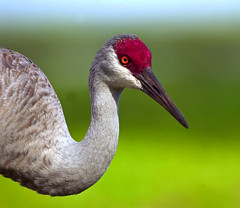 Baby stands a spindly 4½ feet tall, with a wingspan as wide as a pickup bumper, has a long pointy beak and a scarlet bald spot above her bird brain. But she thinks she's human. And for this greater sandhill crane, Grus canadensis tabida, there is no such thing as birds of a feather flocking together: The tens of thousands of cranes now winging across Colorado on their annual migration and overnighting at Fruitgrowers Reservoir scare the bejesus out of her. "This was sort of a last-ditch effort to try to get this crane to be a crane," said Coen Wright. "We were hoping it would connect to a flock."
Baby stands a spindly 4½ feet tall, with a wingspan as wide as a pickup bumper, has a long pointy beak and a scarlet bald spot above her bird brain. But she thinks she's human. And for this greater sandhill crane, Grus canadensis tabida, there is no such thing as birds of a feather flocking together: The tens of thousands of cranes now winging across Colorado on their annual migration and overnighting at Fruitgrowers Reservoir scare the bejesus out of her. "This was sort of a last-ditch effort to try to get this crane to be a crane," said Coen Wright. "We were hoping it would connect to a flock."
An Israeli El AL flight was delayed for several hours after a small bird flew into the cockpit of the plane and refused to leave. The bird came in through an open door of the plane as passengers boarded at the Ben Gurion Airport, near Tel Aviv.
You have to read this special story about an owl named "Owly" who has touched the hearts of many people, and even more remarkably, made a big difference in the life of one special child.
.
The Fine Print: Thanks to Ian, Jeremy and Ellen for sending story links. Thanks in advance to Ian for catching my typos; as you probably know by now, I put a few typographical errors in these documents just so Ian can find them! Images are resized and are either linked from the news story that they accompany or they are credited and linked back to the photographer.
What is the point of Birds in the News? I publish BITN each week because I want to increase people's awareness of the importance of birds in our everyday lives. Birds represent many things to us; beauty, freedom, music, wildness. But everywhere, birds are coming under increasing pressure for their very survival, and by linking to news stories about birds, I hope to make the smallest impression upon the public and the mainstream media, as well as our decision-makers, that birds are an important feature of our everyday lives, that there are so many reasons that we could not do without them.
tags: Birds in the News, ornithology, birds, avian, newsletter



Oh, what a lovely story the one about Owly! Thank you so much for posting this.
Is there a source for the interesting picture and post on the Masked Tityra? I'm interested in reading more about this. Thanks for your wonderful blog. Diane
Something for next installment:
http://news.yahoo.com/s/ap/20070319/ap_on_sc/bird_alarm;_ylt=AnxCZRSORm…
"Nuthatches seem to understand chickadee
By RANDOLPH E. SCHMID, AP Science Writer Mon Mar 19, 7:04 PM ET
WASHINGTON - Nuthatches appear to have learned to understand a foreign language -- chickadee. It's not unusual for one animal to react to the alarm call of another, but nuthatches seem to go beyond that -- interpreting the type of alarm and what sort of predator poses a threat. When a chickadee sees a predator, it issues warning call -- a soft "seet" for a flying hawk, owl or falcon, or a loud "chick-a-dee-dee-dee" for a perched predator."
Bad news on the cactus ferruginous pygmy-owl. Of course a developer would be ready to chortle over the prospect of clearing more square miles of desert for homes, strip centers and golf courses. Such urban sprawl is not sustainable for the long term what with desert conditions, dropping water tables, and the possible end of what Bill Kunstler calls the "cheap oil fiesta," but when was the USA about the long term, anyway? Richard Hofstadter's book, THE AMERICAN POLITICAL TRADITION, among other things debunked the myth of the pioneer yeoman farmer as a careful land steward and painted him instead as a speculator on the move, always looking for cheaper land to the west. It's my understanding that the Civil War was partly sparked because the slave states were using up their soil resources with recklessly exploitative farming practices, forcing the issue on slave vs. free states as the republic expanded westward. So where are the lessons learned? Yeah, right, what lessons?
the bit about the Masked Tityra is something i picked up at BBCNews .. there was no attached story but i am looking for something since rate (and biogeography) of evolution is a fascinating topic.